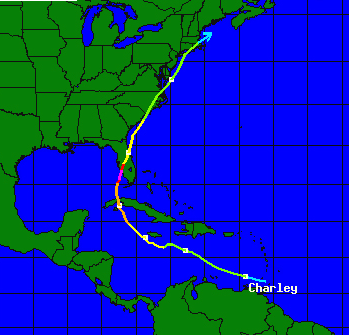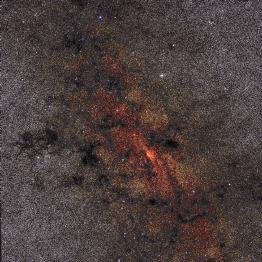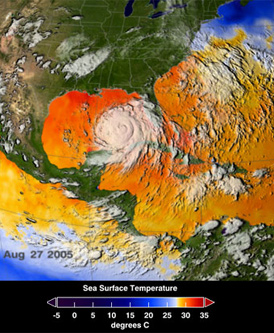Warm ocean waters fuel hurricanes. There was plenty of warm water for Hurricane Katrina to strengthen once it moved into the Gulf of Mexico.
Courtesy of NASA
The 2005 Hurricane Season Is Churning the Atlantic
News story originally written on September 16, 2005
The hurricane season in the North Atlantic is particularly strong this year. And scientists predict that the storms will be getting stronger because of global warming. Follow the links below to find out more.
Windows to the Universe Hurricane Links:
What
Is a Hurricane?
Why
Are Hurricanes Increasing in Strength and Frequency?
How
Hurricanes Form
Eyes
and Eyewalls
Hurricane
Movement
Hurricane
Forecasts
Storm
Surge
Hurricane
Damage
NCAR Kidsí Crossing Hurricane Links:
Hurricanes Impact
Our Lives
Surviving Hurricane
Carla, a Story by Carol Park
How Hurricanes Form
Make a Model of Storm
Surge
Hurricane Safety
Hurricane Strike!
Hurricane science and safety for students
Last modified September 16, 2005 by Lisa Gardiner.
You might also be interested in:

A tropical thunderstorm can grow into a massive hurricane under certain conditions. Sometimes several thunderstorms start rotating around a central area of low pressure. This is called a tropical depression.
...more
How do we know which way a hurricane will go? Forecasters track hurricane movements and predict where the storms will travel as well as when and where they will reach land. While each storm will make its
...more
One of the most dangerous parts of a hurricane isnít the rain or the wind. Itís the flooding caused by storm surge. As a hurricane or other tropical storm moves towards a coast, it can cause sea level
...more
For the first time ever a living giant squid has been photographed! Japanese scientists found and photographed the squid at about 3000 feet (900 meters) below the surface of the Pacific Ocean. You can
...more
Astronomers have identified another exoplanet, that is, a planet outside our solar system. This makes a total of 102 exoplanets that have so far been found by astronomers! The astronomers that identified
...more
Thanks to a couple of telescopes, everyone on the internet can browse through almost 2 million images. Stars throughout the sky were photographed by the Two-Micron All Sky Survey (2MASS) and are now available
...more
Earth may look perfectly spherical from space, like a giant marble, but it actually isn't! Instead, our planet is wider around the equator because matter is forced out as Earth spins (just as you feel
...more
Scientists at the University of Colorado at Boulder found evidence supporting a theory that salt is present on Io. Io is one of Jupiter's many moons. Recent observations from the National Science Foundation's
...more















